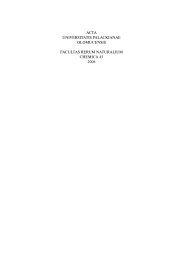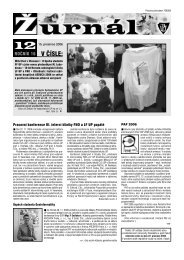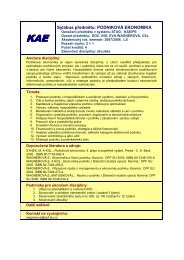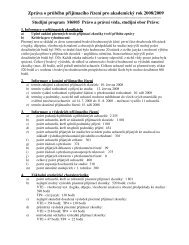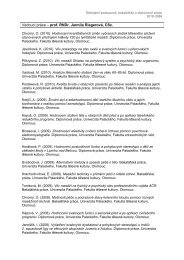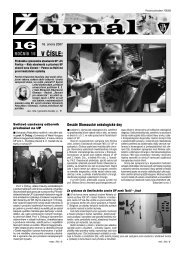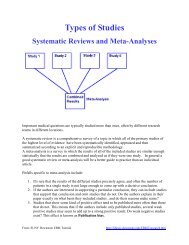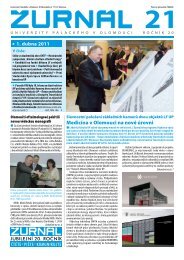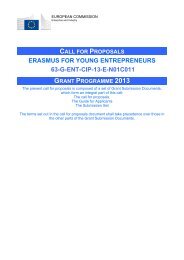ACTA UNIVERSITATIS PALACKIANAE OLOMUCENSIS GYMNICA ...
ACTA UNIVERSITATIS PALACKIANAE OLOMUCENSIS GYMNICA ...
ACTA UNIVERSITATIS PALACKIANAE OLOMUCENSIS GYMNICA ...
- No tags were found...
Create successful ePaper yourself
Turn your PDF publications into a flip-book with our unique Google optimized e-Paper software.
Acta Univ. Palacki. Olomuc., Gymn. 2004, vol. 34, no. 2 57activity out of the registered frequency spectrum isregarded as activity in the HF zone that is not boundto respiration as an activity originating probablyfrom parasympathetically directed signals from innerorgans. (Confirmation of hypothesis no. 5.)REFERENCESAkselrod, S., Gordon, D., Madwed, J. B., Snidman, N.C., Shannon, D. C., & Cohen, R. J. (1985). Hemodynamicregulation: Investigation by spectral analysis.American Journal of Physiology, 18, 867–875.Akselrod, S., Gordon, D., Ubel, F. A., Shannon, D. C.,& Cohen, R. J. (1981). Power spectrum of heart ratefluctuations: A quantitative probe of beat-to-beat cardiovascularcontrol. Science, 213, 220–223.Baštecký, J., Šavlík, J., & Šimek, J. (1993). Psychosomatickámedicína. Praha: Grada – Avicenum.Benson, H., & Starková, M. (1997). Moc a biologievíry v uzdravení (Černý, V. A., Trans). Praha: Práh.(Original work published 1996).Brown, T. E., Beightol, L. A., Koh, J., & Eckberck, D. L.(1993). The important infuence of respiratorion onhuman R-R interval power spectra is largely ignored.Journal of Applied Physiology, 75, 2310–2317.Cacioppo, J. T., Bernston, G. G., Binkley, P. F., Quigley,K. S., Uchino, B. N., & Fieldstone, A. (1994).Autonomic cardial control. II. Basal response,noninvasive indices, and autonomic space as revealedby autonomic blockades. Psychophysiology,31, 586–598.Dostálek, C. (1996). Hathajóga. Praha: Karolinum.Dostálek, C., & Krása, H. (1976). Vliv dechovéfáze na tvorbu podmíněného refl exu u člověka.Československá psychologie, 18, 401–410.Dylevský, I., Druga, R., & Mrázková, O. (2000). Funkčníanatomie člověka. Praha: Grada.Fabián, Z., Lepičovská, V., & Dostálek, C. (1982). Onthe analysis of quasiperiodical changes in EEC andrespiration during breathing exercises. Acta Nerv.Super., 24(3), 173–174.Frostel, C., Pande, J. N., & Hedenstierna, G. (1983).Effects of high-frequency breathing on pulmonaryventilation and gas exchange. Journal of AppliedPhysiology, 55(6), 1854–1861.Ganong, W. F. (1999). Přehled lékařské fyziologie. (J.Berger a kolektiv, Trans.). Praha: H & H. (Originalwork published 1961).Goldberger, A. L., Findley, L. J., Blackburn, M. R., &Mandell, J. A. (1984). Nonlinear dynamics in heartfailure: Implications of longwavelength cardiopulmonaryoscillations. American Heart Journal, 107,612–615.Goldberger, J. J., Ahmed, M. W., Parker, M. A., & Kadish,A. H. (1994). Dissociation of heart rate variabilityfrom parasympathetic tone. American Journal ofPhysiology, 266, H2152–H2157.Gore, M. M., & Gharote, M. L. (1987). Intermediateeffect of a minute of kapalabhati on respiratory functions.Yoga Mimamsa, 35(3–4), 14–23.Grossman, P. (1992a). Breathing rhythms of the heart ina world with no steady state: A comment on Weber,Molenaar, and van der Molen. Psychophysiology, 29,66–72.Grosmann, P. (1992b). Respiratory and cardiac rhythmsas a window to central and autonomic behavioralregulation: Selection frames, keeping the panes cleanand viewing neural topography. Biological Psychology,34, 131–161.Grossman, P., Karemaker, J., & Wieling, W. (1991).Prediction of tonic parasympathetic cardiac controlusing respiratory sinus arrytmhia: The need for respiratorycontrol. Psychophysiology, 28, 201–216.Grossman, P., & Kollai, M. (1993). Respiratory sinus arrythmia,cardiac vagal tone and respiration: Withinand between-subject relations. Psychophysiology, 30,486–495.Grossman, P., van Beek, J., & Wietjes, C. (1990) A comparisonof three quantification methods for estimationof respiratory sinus arrythmia. Psychophysiology,27, 702–714.Hayano, J., Sakakibara, Y., Yamada, A. et al. (1991).The accuracy of the assessment of cardiac vagal toneby heart rate variability in normal subjects. AmericanJournal of Cardiology, 67, 199–204.Ježek, M. (2001). Vliv jógových dechových technik nafunkční změny autonomního nervového systému.Diplomová práce, Univerzita Palackého, Fakultatělesné kultury, Olomouc.Katona, P. G., & Jih, F. (1975). Respiratory sinus arrythmia:A noninvasive measure of parasympatheticcardiac control. Journal of Applied Physiology, 39,801–805.Kolisko, P., Salinger, J. et al. (1997). Jógová cvičení a diagnostikafunkčních změn autonomního nervovéhosystému pomocí diagnostického systému TF 3, 4.Olomouc: Fakulta tělesné kultury.Kolisko, P., Salinger, J., Opavský, J., Stejskal, P., Jandová,D., Slováček, K., & Ježek, M. (2001). Vliv řízenéhoa spontánního dýchání na změny funkčního stavuautonomního nervového systému. In H. Válková &Z. Hanelová (Eds.), Pohyb a zdraví (pp. 269–275).Olomouc: Vydavatelství Univerzity Palackého.Kollai, M., & Mizsei, G. (1990). Respiratory sinus arrythmiais a limited measure of cardiac parasympatheticcontrol in humans. Journal of Physiology, 424,329–342.Lepičovská, V., & Dostálek, C. (1981). ECG changesproduced by some hathayogic exercies. Acta Nerv.Super., 23, 539–552.



